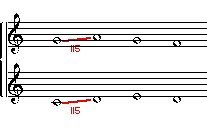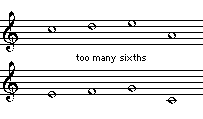The subject of dissonance might need a little discussion: Dissonance is not permitted in 2-part First Species writing, and some authorities would forbid all dissonance even in 3 or more parts. But Fux allows certain dissonances between the upper voices when writing in 3 or more parts. With regard to an example in which his student has written what we would call a first inversion diminished triad he says one should avoid that diminished fifth between upper voices "if possible," but that the no-dissonance rule "is not very strictly applied in composition of several parts." We will follow Fux and allow diminished fifths or augmented fourths natural to the scale if they do not involve the bass voice.
Melodic movement:
 No voice should make a leap larger than a fifth, except for the octave and the ascending minor sixth.
No voice should make a leap larger than a fifth, except for the octave and the ascending minor sixth.
 Avoid making successive same-direction leaps in the same voice unless they outline a triad. If they can't be avoided they should at least total less than an octave.
Avoid making successive same-direction leaps in the same voice unless they outline a triad. If they can't be avoided they should at least total less than an octave.
 Leaps greater than a fifth should be compensated by movement in the opposite direction. If the leap is ascending make sure the compensation is stepwise.
Leaps greater than a fifth should be compensated by movement in the opposite direction. If the leap is ascending make sure the compensation is stepwise.

 A leap of an octave should be balanced: preceded and followed by notes within the octave.
A leap of an octave should be balanced: preceded and followed by notes within the octave.

 No voice should move by a chromatic interval (any augmented or diminished interval).
No voice should move by a chromatic interval (any augmented or diminished interval).

 Avoid repeating a pitch when possible, especially in the lowest voice. In upper parts you can repeat a pitch as many as three times successively if necessary.
Avoid repeating a pitch when possible, especially in the lowest voice. In upper parts you can repeat a pitch as many as three times successively if necessary.
 Keep each voice confined to a singable range for the part, preferably not exceeding a tenth from its highest to its lowest pitch.
Keep each voice confined to a singable range for the part, preferably not exceeding a tenth from its highest to its lowest pitch.
Rhythm:
 Voices all move together in the same rhythm as the cantus firmus. For traditional exercises all notes are whole notes.
Voices all move together in the same rhythm as the cantus firmus. For traditional exercises all notes are whole notes.
Independence of voices:
 Avoid writing parallel fifths or octaves (moving two voices in the same direction from one fifth or octave to another).
Avoid writing parallel fifths or octaves (moving two voices in the same direction from one fifth or octave to another).

 Avoid writing direct fifths or octaves (moving two voices in the same direction to a fifth or an octave). There are exceptions: these may be acceptable at a cadence, or if one voice is inner and the exposed voice moves stepwise. Direct fifths in the outer voices will be accepted if the upper voice moves by step.
Avoid writing direct fifths or octaves (moving two voices in the same direction to a fifth or an octave). There are exceptions: these may be acceptable at a cadence, or if one voice is inner and the exposed voice moves stepwise. Direct fifths in the outer voices will be accepted if the upper voice moves by step.
 Do not let two voices leap to a perfect interval unless one of them is an inner part.
Do not let two voices leap to a perfect interval unless one of them is an inner part.
 Avoid parallel fourths unless the lower tone of the fourth is not the bass and the pitch class a third below that note is present (that is, parallel 1st-inversion triads are OK).
Avoid parallel fourths unless the lower tone of the fourth is not the bass and the pitch class a third below that note is present (that is, parallel 1st-inversion triads are OK).

 Avoid writing more than three of the same interval in a row in any two parts (e.g. four consecutive thirds or four consecutive sixths).
Avoid writing more than three of the same interval in a row in any two parts (e.g. four consecutive thirds or four consecutive sixths).

 Upper voices can sometimes cross if necessary, but avoid "overlapping" (in an overlap voices do not cross, but one moves to a position that is at or beyond the previous pitch of another voice).
Upper voices can sometimes cross if necessary, but avoid "overlapping" (in an overlap voices do not cross, but one moves to a position that is at or beyond the previous pitch of another voice).

 Do not move to an octave with leaping motion in either voice unless the movement is oblique (one voice remaining on the same pitch).
Do not move to an octave with leaping motion in either voice unless the movement is oblique (one voice remaining on the same pitch).
 One perfect interval can follow another in the same voices only if one of the voices moves stepwise.
One perfect interval can follow another in the same voices only if one of the voices moves stepwise.
 Avoid the unison except at the beginning or end. Authorities disagree: Fux forbids unisons except at terminals (though he occasionally shows on in his examples). Jeppeson is much more free with unisons. But since these exercises are mostly based on the Fux method we'll keep his objection to unisons.
Avoid the unison except at the beginning or end. Authorities disagree: Fux forbids unisons except at terminals (though he occasionally shows on in his examples). Jeppeson is much more free with unisons. But since these exercises are mostly based on the Fux method we'll keep his objection to unisons.
 In all species of counterpoint, use contrary motion frequently to emphasize the independence of voices.
In all species of counterpoint, use contrary motion frequently to emphasize the independence of voices.
Dissonance handling:
 In first species there is no dissonance, so the only harmonic intervals allowed are the thirds, sixths, fifth, and octave (and, when in 3 parts or more, the fourth if its lower tone is not the bass). The diminished fifth and augmented fourth will be considered consonant if they are not formed with the bass. Note also Fux's admonition that full triads should be used whenever possible, and when that is not possible use thirds and sixths in preference to "empty" fifths.
In first species there is no dissonance, so the only harmonic intervals allowed are the thirds, sixths, fifth, and octave (and, when in 3 parts or more, the fourth if its lower tone is not the bass). The diminished fifth and augmented fourth will be considered consonant if they are not formed with the bass. Note also Fux's admonition that full triads should be used whenever possible, and when that is not possible use thirds and sixths in preference to "empty" fifths.
Harmony:
 If in two parts the music must begin and end with perfect consonances (octaves, fifths, or unisons). Octaves or unisons are preferrred at the end, and Jeppeson says that an octave or unison is the only choice if the cantus firmus is above the counterpoint. Counterpointer will allow a fifth. In three or more parts you can begin and end with full triads, but the ending must be either a major triad or a perfect consonance. Fux advises that if the mode does not contain a major third over the tonic, then it is best to leave the third out of the final chord rather than to raise it to a major third. However, a concluding major triad was common practice and is acceptable here.
If in two parts the music must begin and end with perfect consonances (octaves, fifths, or unisons). Octaves or unisons are preferrred at the end, and Jeppeson says that an octave or unison is the only choice if the cantus firmus is above the counterpoint. Counterpointer will allow a fifth. In three or more parts you can begin and end with full triads, but the ending must be either a major triad or a perfect consonance. Fux advises that if the mode does not contain a major third over the tonic, then it is best to leave the third out of the final chord rather than to raise it to a major third. However, a concluding major triad was common practice and is acceptable here.
 The cantus firmus will always begin and end with the tonic. If the cantus firmus is in an upper voice be sure not to harmonize it with a fifth below at the beginning. That would give the impression of a different mode.
The cantus firmus will always begin and end with the tonic. If the cantus firmus is in an upper voice be sure not to harmonize it with a fifth below at the beginning. That would give the impression of a different mode.
 Avoid placing the chromatically altered form of a note immediately adjacent to its unaltered form in a different voice (i.e. cross relation).
Avoid placing the chromatically altered form of a note immediately adjacent to its unaltered form in a different voice (i.e. cross relation).
 In two-part writing, avoid adjacent use in different voices of two pitches that form the tritone (tritone cross relation).
In two-part writing, avoid adjacent use in different voices of two pitches that form the tritone (tritone cross relation).
 In general keep to the pitch classes of the mode expressed by the cantus firmus. Unless you transpose a cantus firmus this will in practice mean the "white key" notes in Counterpointer's species exercises. Non-modal tones may be introduced, however, if they accord with conventional principles for altered tones.
In general keep to the pitch classes of the mode expressed by the cantus firmus. Unless you transpose a cantus firmus this will in practice mean the "white key" notes in Counterpointer's species exercises. Non-modal tones may be introduced, however, if they accord with conventional principles for altered tones.
 Previous
Next
Previous
Next 
Table of Contents
©2009 Ars Nova Software, LLC